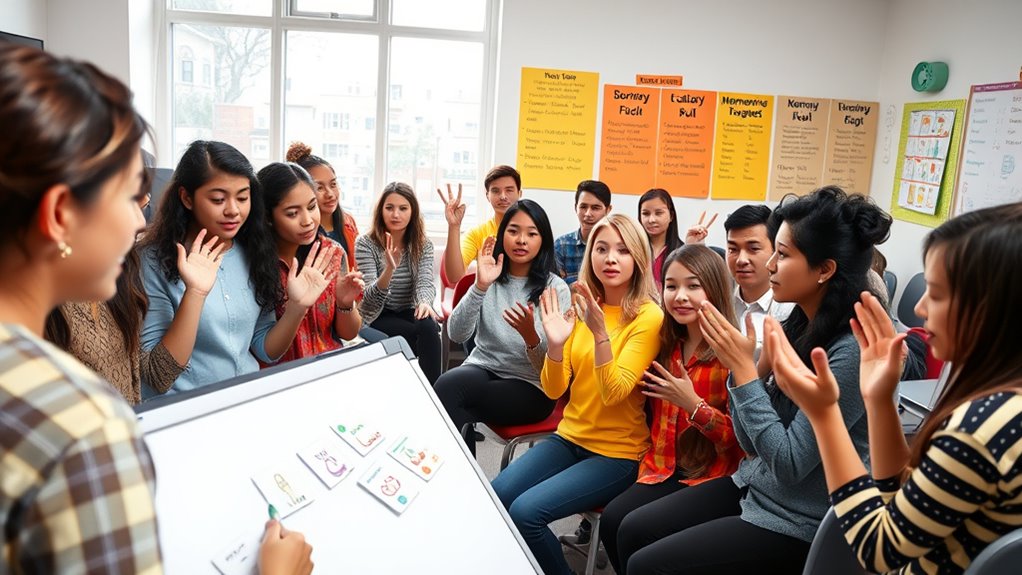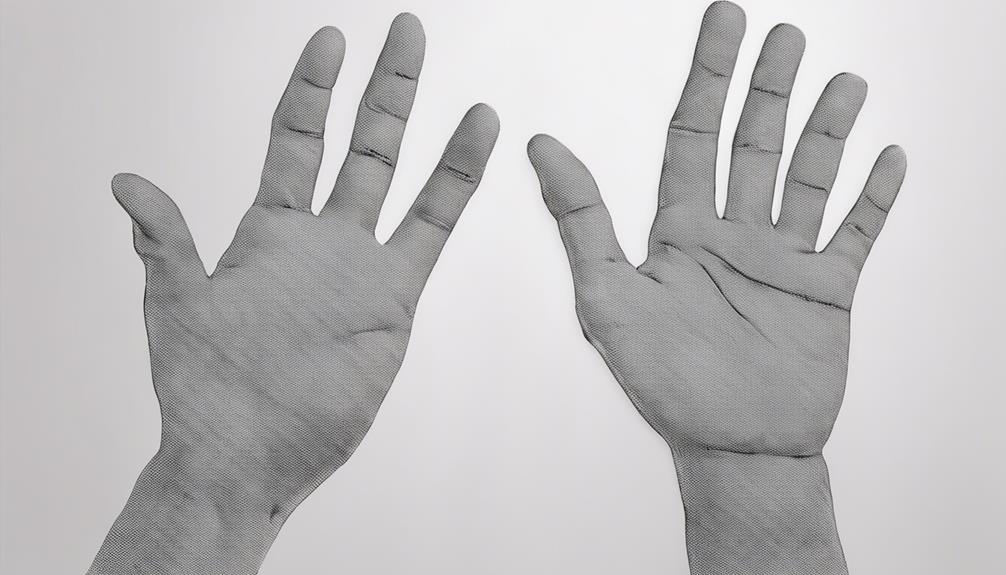To learn ASL faster, focus on proven memory techniques like active gesture recognition, which helps you identify hand shapes, movement, and facial expressions quickly. Use association and visualization to link signs with familiar objects, making recalling signs easier. Practice regularly with spaced repetition, reviewing signs at increasing intervals to boost retention. Incorporate mnemonic devices for tricky signs and immerse yourself in signing environments. Keep improving your skills, and you’ll discover more effective methods as you go.
Key Takeaways
- Use association and visualization to connect signs with familiar objects or concepts for quicker recall.
- Practice gesture components—hand shape, movement, facial expression—actively to improve recognition speed.
- Apply spaced repetition by reviewing signs at increasing intervals to reinforce long-term memory.
- Create mnemonics or stories to remember complex signs or sequences more effectively.
- Engage in consistent, real-life practice to strengthen neural pathways and develop intuitive signing skills.

Are you enthusiastic to learn American Sign Language (ASL) quickly and effectively? If so, tapping into proven memory techniques can make a significant difference in your progress. One of the most important skills you’ll develop early on is gesture recognition. When you focus on improving this skill, you’re training your brain to identify and interpret various signs more rapidly, which accelerates your learning process. Instead of passively watching signs, actively engage with them. Break down each gesture into its component parts—hand shape, movement, facial expression—and practice recognizing these elements in context. As you become more adept at gesture recognition, you’ll find yourself understanding signs faster and more accurately, paving the way for smoother communication.
Improve ASL faster by focusing on gesture recognition—break down signs into components and practice identifying them in context.
Another critical aspect is vocabulary expansion, which directly impacts your ability to communicate confidently. To boost your vocabulary efficiently, use techniques like association and visualization. Link new signs to familiar objects or concepts, creating mental images that reinforce memory. For example, when you learn the sign for “food,” visualize your favorite dish or a meal you enjoy. This method creates strong neural connections, making recall easier over time. Flashcards, especially digital ones that include videos of native signers, can serve as effective tools for repetitive practice and reinforcement. The more signs you actively review, the more they become ingrained in your memory, reducing the effort needed to recall them during conversations.
Incorporating spaced repetition into your study routine amplifies these benefits. Instead of cramming, review new signs at increasing intervals—after one day, then three days, then a week. This technique leverages your brain’s natural learning processes, strengthening long-term retention. Additionally, practicing gesture recognition in real-life situations or with a study partner helps solidify your understanding. When you see a sign in context, your brain associates it with its meaning more naturally, making future recognition faster. Engaging with immersive environments like signing communities or using multimedia resources can further enhance your gesture recognition skills by exposing you to diverse signing styles and contexts.
Using mnemonic devices can also aid in memorizing tricky signs or sequences. For example, create stories or associations for complex signs to make them more memorable. Combining these memory techniques—gesture recognition drills, vocabulary association, spaced repetition, and mnemonics—will help you learn ASL faster and more effectively. Consistency is key; the more you practice and apply these strategies daily, the quicker you’ll notice improvements. Remember, learning ASL isn’t just about memorizing signs—it’s about building a dynamic, intuitive understanding of a rich language. With dedication and smart techniques, you’ll be communicating confidently in no time.
Frequently Asked Questions
How Long Does It Typically Take to Become Fluent in ASL?
You wonder how long it takes to become fluent in ASL. Your learning progress depends on your study consistency and practice time. Usually, with regular practice, you might reach conversational fluency in about 6 months to a year. However, becoming fully fluent could take 1-2 years or more. Staying consistent, engaging with native signers, and practicing daily will speed up your progress and help you achieve your language goals faster.
Are There Specific Apps Recommended for Learning ASL Quickly?
When choosing ASL learning apps, you want effective practice tools that boost your progress quickly. Some top ASL learning apps include The ASL App, SignSchool, and Marlee Signs, which offer interactive lessons and real-time feedback. These apps help you practice vocabulary, gestures, and facial expressions efficiently. By consistently using these effective practice tools, you’ll accelerate your learning, making it easier and faster to become proficient in ASL.
Can Memory Techniques Help With ASL Facial Expressions?
Imagine you’re at a busy café, trying to recall a friend’s facial expression to understand their mood—coincidence! Memory techniques can definitely help with facial expression memorization and non-manual signal recall. By associating specific expressions with keywords or stories, you strengthen your mental links, making it easier to remember subtle cues. These strategies boost your ability to interpret and reproduce facial signals, enhancing your overall ASL fluency faster and more confidently.
What Are Common Mistakes Beginners Make When Learning ASL?
When learning ASL, you might make mistakes like confusing sign language slang or slipping into finger spelling pitfalls. You often focus on memorizing signs without practicing facial expressions, which are essential. You may also neglect to learn cultural nuances or rely too heavily on gestures without understanding context. These errors slow your progress, but practicing with native signers and paying attention to facial cues help you improve faster.
How Can I Practice ASL Effectively Without a Fluent Partner?
Imagine your hands as a mirror reflecting your progress. You can practice ASL effectively alone by using gesture repetition to reinforce signs and visual mnemonics to create mental images. Record yourself signing, then watch and compare to improve. Use flashcards with pictures and signs. Repeating gestures helps solidify memory, and visual cues make learning engaging. This way, you strengthen your skills even without a fluent partner.
Conclusion
Now that you’ve revealed these proven memory techniques, imagine your ASL journey as a vibrant tapestry, each new sign weaving seamlessly into your mind’s fabric. With every practice session, you’re adding bright, bold stitches that bring your understanding to life. Keep weaving, keep practicing, and watch your skills blossom like a garden in full bloom. Before long, you’ll be fluent, your confidence shining like the sun breaking through a cloudy sky.











